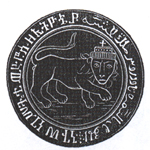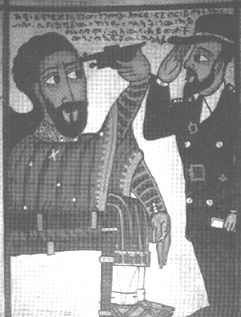Tewodros II
Tewodros II was born Kassa Hailu sometime around 1818. His father, Hailu Welde Giyorigis, was the ruler of Qwara district, located on the Ethiopian-Sudanese border. His military experience started when he served in his half brother’s army (Prouty and Rosenfeld 1982, 71). His half brother died in 1839 and Qwara was lost to the family and claimed by Empress Menen of Gondar. Kassa Hailu resorted to become a shifta, one who refuses to recognize his feudal lord. Kassa Hailu organized his own army in the plains of Qwara. When he became too powerful to ignore, as a way to deal with him with out using force, he was named dajazmach of Qwara and given the hand of Tawabach, the daughter of Ras Ali of Begemder, in 1845. (Zewde 2001, 28)

Kassa was very close to Tawabach and devoted to his marriage but his submission to Empress Menen was short-lived. In October 1846, he attacked and plundered Dembea, a city located due south of Gondar, and in January 1847 he went on to occupy Gondar. When Kassa unoccupied Gondar later that year, Empress Menen sent an army after him into north of Lake Tana. Kassa easily defeated the army and took the Empress as prisoner (Marcus 2002, 60). Her son, Ras Ali of Begemder, chose to negotiate with Kassa; he gave Kassa all lands west and north of Lake Tana and Kassa in return released his mother (Prouty and Rosenfeld 1982, 60). The reconciled relationship with Empress Menen led him to join up with Ras Ali and Ras Goshu Zewde of Gojam. However, when conflict reemerged yet again in 1852, Kassa retreated back to Qwara to re-strengthen his troops (Henze 2001, 134-5).

From that point on, Kassa never looked back. On 27 November 1852, he defeated Ras Goshu’s Gojami army. On 12 April 1853, Kassa defeated four armies from Wallo, Yajju, Tigray, and Gojam that were formed by Ras Ali. On 29 June 1853 he defeated Ras Ali’s troops but Ras Ali and Empress Menen were able to escape into the Yajju territory. On 9 February 1855, Kassa defeated the last important ruler of the Zamana Masafent, Dajazmach Webe Hayle Mariam of Tigray (Zewde 2001, 29-30) Two days later, Kassa Hailu was crowned king of kings of Ethiopia as Tewodros II at Webe’s church Deresge Mariam, by the Coptic Metropolitan, Abuna Salama. (Marcus 2002, 64)
When he became emperor, he set out to reunify and modernize Ethiopia. However, his ideals never materialized because he spent most of his time on military expeditions. After he established Dabara Tabor as his capital, located 60 miles south-east of Gondar, he went on to concur Tigray, Wallo, and Shawa, but only for a short time. The appointed leaders of those regions were either too weak or disloyal. When unable to bring all of Ethiopia under his control, and fearing a threat of an attack by the Egyptians from the north and Turks from the Red Sea, Tewodros attempted to ally himself with England. In October 1862, he sent a letter to Queen Victoria asking her to aide him oust the Turks form the Red Sea. The letter was answered nearly two years later only after Tewodros in anger had priosoned English subjects (Pankhusrt 1998, 154). By 1868, the British were in Ethiopia with an army of 32,000 content on destroying Tewodros. They got cooperation from Dejazmach Kassa Mercha of Tigray. Tewodros was well ahead prepared for the British in Magdala, where the British subjects were being held. The British began their assault on 10 April 1868. The next day, Tewodros released the prisoners, but it was not enough to save Tewodros. On 13 April, the British unleashed their final attack. That evening, Tewodros committed suicide. Soon afterwards, the British burned Magdala and duly left the country (Henze 2001, 139-142).

When the British first entered Ethiopia, they had received cooperation from Kassa Mercha and had promised that they would leave as soon as they dealt with Tewodros. When they left, they rewarded "Kassa for his cooperation by presenting him with six mortars, six howitzers, as well as 850 muskets, and a goodly supply of ammunition." (Pankhurst 2001, 160-1). This surprising gift from the British helped him to overcome Wag Shum Gobaze of Lasta and Menelik of Shewa to become the next emperor of Ethiopia. Upon his coronation, he became Yohannes IV (Marcus 2002, 42).